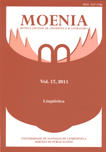Expresión y contacto: dimensiones de la afectividad en prosodia
Contenido principal del artículo
Resumen
En este trabajo, se exploran las distintas dimensiones de la afectividad relacionadas con la prosodia del habla. En primer lugar, se distinguen los distintos códigos verbales que intervienen en el intercambio comunicativo, entre los que hay que distinguir los que están fijados socialmente (códigos estables) y los que deben negociar los interlocutores (códigos semiestables). En segundo lugar, se propone un método objetivo para el análisis acústico de la prosodia en su conjunto: además de la entonación (la melodía del habla), la dinámica (el juego de intensidades dentro del enunciado) y el ritmo (el juego de duraciones). Más adelante, se caracteriza funcionalmente el lenguaje afectivo y los códigos que intervienen en él. Finalmente, se explica cómo la prosodia es el contenedor (o recipiente fónico) de todos los contenidos lingüísticos que se ponen en juego en la comunicación. En conjunto, las dimensiones de la afectividad en prosodia se relacionan con: la expresión de emociones, cortesías y foco, la modalización de la información y el contacto entre los interlocutores.


